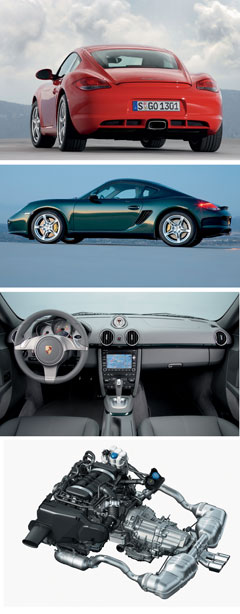Porsche peps up credit-crunched Cayman
BY JAMES STANFORD | 1st Dec 2008

It believes the substantially revised coupe, which has more power, uses less fuel and is available with a new dual-clutch automatic transmission, will put it in a better position for when the world's economy recovers.
The facelifted Cayman will go on sale in Australia next March, alongside the similarly upgraded Boxster convertible.
Introduced in 2005, the first-generation 'affordable' Porsche coupe has now undergone its first substantial revision, although most of the changes are mechanical and there are few visible styling alterations.
For those who prefer an automatic transmission, the most important part of the Cayman upgrade is the addition of Porsche's new Doppelkupplungsgetriebe (PDK) twin-clutch self-shifting transmission.
PDK is already available in the facelifted 911 range, although in this application it is packaged differently due to the different position of the engine.
In the 911, the engine sits at the back of the vehicle and therefore the gearbox sits in front of the engine. The Cayman's engine sits behind the driver and passenger but in front of the rear axle, so the PDK transmission is attached to the back of the engine.
Apart from the packaging changes, the PDK in the Cayman and Boxster is the same as that in the 911.
Dual-clutch automated manual gearboxes feature two interacting clutches, one which operates the even gears and the other operating the odd gears. The big advantage, which Porsche says makes the PDK 60 per cent faster than conventional manuals and other automatics, is that the next gear required in place and ready to go when the gearchange is made.

In the Porsche, you can change gears by pushing the gearshift backwards and forwards or using the steering wheel-mounted paddles.
Purchasing the optional Sports Chrono package unlocks a launch control program and a Sports Plus setting which allows for super-fast gearchanges.
Porsche has done a lot of work on both six-cylinder Cayman engines. It has increased the displacement of the 2.7-litre engine to 2.9 litres, while the displacement of the 3.4-litre six stays the same.
The most significant change for the larger engine is the introduction of direct fuel-injection technology.
Both engines feature a new closed deck, single-piece cylinder-heads and a new valve system and cooling ducts.
Changes have also been made to the intake and exhaust system which places the catalysts closer to the cylinders in order to further reduce emissions. Porsche engineers also introduced a new twin-chamber exhaust pipe which it has tuned for an even sportier sound.
The changes increase the output of the smaller engine by 15kW and 27Nm to 195kW and 300Nm.
Porsche has also replaced its five-speed manual with a six-speed manual.
The PDK-equipped 2.9-litre Cayman is now able to dash to 100kmh in a claimed 5.7 seconds - an improvement of 1.3 seconds over the previous Tiptronic automatic model.
The manual Cayman 2.9 does the same sprint in 5.7 seconds - down from 6.1 seconds for its predecessor.
The performance of the 3.4-litre Cayman engine has been increased by 18kW and 30Nm, to 235kW and 370Nm.
Running a PDK gearbox, it is able to dash to 100km/h in just 5.1 seconds, which is a one-second improvement over the Tiptronic automatic.
Using the optional launch control feature, the Cayman S is able to break the five-second barrier for the first time, doing the 0-100km/h dash in just 4.9 seconds.
The internal upgrades have resulted in some fuel economy improvements as well, with consumption figures ranging from 8.9 litres per 100km for the PDK-equipped Cayman to 9.4L/100km for the Cayman S manual.
The Cayman chassis has also been upgraded with re-calibrated suspension. The springs, dampers and anti-roll bars have all been revised and the dampers tuned for less resistance.
The standard Cayman has 20mm larger front brake discs, at 318mm, while the Cayman S front discs remain at 318mm. Potent brakes have always been a Porsche strength and the Cayman and Cayman S are both equipped with four-piston callipers.
As is the case with the last Cayman, the new cars are available with an advanced ceramic braking package, which is identifiable by their yellow callipers.
In the name of fuel economy, Porsche has reduced the rolling resistance of the tyres for the Cayman and fitted them to newly designed wheels.
The standard wheel size for the Cayman is 17 inches, while 18-inch units are standard on the Cayman S and both cars can be fitted with optional 19-inch rims.
The exterior changes are best described as subtle. There is a new front bumper fitted with an LED circular light and a narrow strip of daytime running lights.
The headlights are the same shape, but now have 'twin-tube' lights which look slightly different.
At the back, the tail-lights are a different shape and now use LED technology, while the rear bumper is also new. The wing mirrors are also larger.
Porsche has introduced four new paint colours, including a lime green and bright orange that are a bright as some of the Smarties colours.
The interior is essentially the same as the previous model except for a re-designed centre console, which features new climate controls and a smaller number of control buttons.
The Cayman options list is even longer and included a range of new features, including a mechanical rear differential available for models that run 18-inch or 19-inch wheels.
There is a new tyre pressure monitoring system, new bi-Xenon headlights with self-washing function, a heated steering wheel, seat ventilation, a new sound system with a 40GB hard drive, upgraded satellite-navigation and a new audio interface for external sources including USB cards and MP3 players.
Pricing for the new Cayman and Cayman S will be locked in closer to next year's launch. Pricing for the current model stands at $121,600 for the Cayman manual and $154,400 for the Cayman S manual.
Read more:
First official look: Porsche parades PanameraLA show: Mid-life makeover for Boxster and Cayman